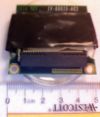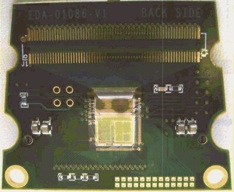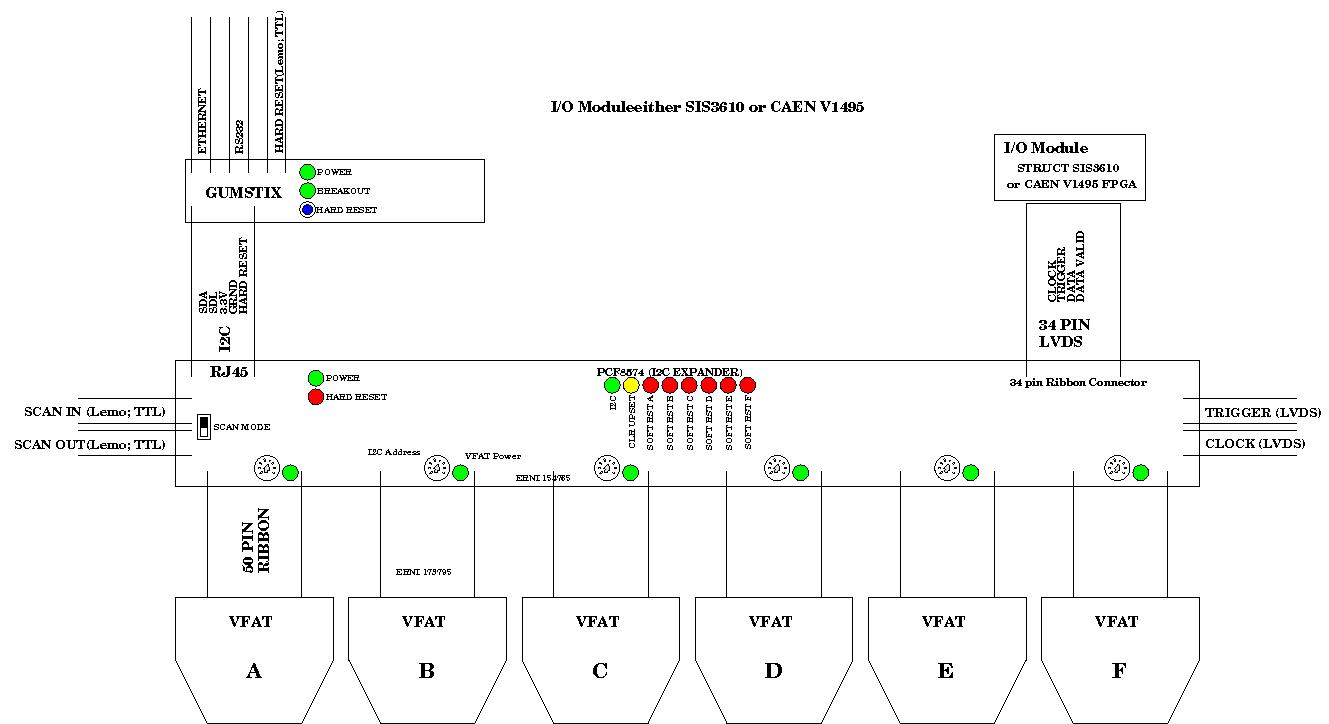VFAT readout electronics
This page describes the GEM detector readout system for the Qweak experiment. The system has four components, the VFAT readout card from CERN, a signal breakout box, a Gumstick I2C control computer, and an I/O VME module to record the LVDS output from the VFAT card.
VFAT readout Block Diagram
The diagram below describes the detector readout electronics for a GEM detector instrumented with 6 VFAT boards. Each VFAT board has 128 radout channels which are output through a single LVDS data line in series. A VFAT board from CERN is evaluated for use as a readout board to convert the GEM output analog signal to a digital signal.
VFAT Board specifications
Photos of the top and bottom side of the VFAT card are shown below. The top side has a 50 pin connector whcih goes to the breakout box to separate I2C control signals and LVDS data I/O signals. The bottom side attaches to the GEM detector readout board via a 130 pin header connector.


Signals
LVDS Signals to I/I module using 34 pin ribbon cable
I2C signals
Breakout box specs (preliminary)
The breakoutbox is a circuit board with no active elements that separates the I2C command signal lines from the LVDS data I/O lines. The box is designed to support 6 VFAT readout cards. The box is being design to be mounted on the detector rotator. All 6 VFAT cards will have their signal lines go into the break out box. The I2C lines will then go our of the breakout box along an RJ45 standard ethernet cable. The LVDS lines will exit though a standard 34 pin ribbon cable(Connector type Robinson Nugent P50E-068-P1-SR1-TG).
- 6 inputs for ~1m ribbon cables from VFAT modules
- 3-bit DIP switch to select I2C address range for each VFAT
- Soft reset for each VFAT controlled via I2C expander chip
- Shared hard reset line from Gumstix
- Scan Mode switch
- ScanIn connector (cascaded)
- ScanOut connector (cascaded)
- RJ45 port to gumstix box containing I2C and other signals:
- Power (3.3 or 2.5V)
- Ground
- SDA
- SCL
- Hard Reset
- Extra line for Link detection
- 34 pin ribbon connector for LVDS signals
- LEMO connector for LVDS trigger input
- LEMO connector for LVDS Master Clock
- I2C expander(s) for status LEDs (socketed)
- Status LEDs:
- Power (from I2C line)
- I2C connect (flashing through I2C expand)
- Power for each VFAT (feedback through common pins on VFAT board?)
- Hard Reset LED
- Clear UpsetReg (SEU counter) via I2C expand
Ribbon cable pinouts
| # | Name | Value | Test rig color Primary/Second |
| B1 | DGND | Digital Ground | Black/Grey (shared) |
| A1 | DVDD | +2.5V | Red/Grey (shared) |
| B2 | SDA | I2C Data | Green/Yellow |
| A2 | SCL | I2C Clock | Yellow/Green |
| B3 | DGND | Digital Ground | Black/Grey (shared) |
| A3 | DVDD | +2.5V | Red/Grey (shared) |
| B4 | |||
| A4 | |||
| B5 | I2C ADDR 2 | I2C Address Most | White/Blue |
| A5 | I2C ADDR 1 | I2C Address Middle | White/Orange |
| B6 | I2C ADDR 0 | I2C Address Least | White/Green |
| A6 | REH-S | Soft Reset (Program saved) | White/Grey |
| B7 | |||
| A7 | REH-B | Hard Reset | Grey/White |
| .............. | |||
|---|---|---|---|
| B22 | DGND | Digital Ground?? | |
| A22 | SCAN E | ||
| B23 | AGND | Analog Ground | |
| A23 | AVDD | 2.5V | Grey/Red |
| B24 | AGND | Analog Ground | |
| A24 | AVDD | 2.5V | Grey/Red |
| B25 | AGNDD | Analog Ground?? | Grey/Black |
| A25 | AVDD | 2.5V | Grey/Red |
The PC board-mount socket for the cable is ERNI 154765 for reel or ERNI 063197 for tube packaging.
The cable crimp-ons are ERNI 024403 or premade cables 300mm long are ERNI 173795
Gumstick I2C controller
The gumstix motherboard used is the verdex XL6P. It has a 600MHz Marvell XScale processor, 128MB of RAM, and 32MB of flash.
The 120 pin expansion socket has a netCF-vx network interface card for TCP/IP networking. This card also has a Compact Flash slot should additional storage be required.
The 60 pin expansion socket has a breakout-vx card to allow access to the I2C signals, serial ports, and various other GPIO possibilities.


